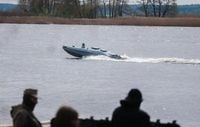In a significant escalation of military engagements in the Black Sea region, Ukrainian forces have reportedly achieved a historic first by using a naval drone to destroy a Russian Su-30 fighter jet. The incident occurred on May 2, 2025, near the naval base in Novorossiysk, a site that has been pivotal for the Russian Black Sea Fleet.
According to the Main Intelligence Directorate of Ukraine (HUR), the operation was executed by soldiers from HUR Group 13, who utilized the Magura V5 unmanned sea drone to strike the aircraft. This marks the first time a combat aircraft has been destroyed by a maritime drone, an event that could redefine naval warfare tactics.
The HUR confirmed the successful strike through a post on its Telegram channel on May 3, stating, "This is the first destruction of a combat aircraft by a naval drone in the world." The drone was reportedly equipped with a missile that targeted the Su-30, which is valued at approximately $50 million.
As the drone struck, the aircraft was seen engulfed in flames before it fell into the sea, underscoring the effectiveness of this new technology in combat. The strike took place in an area where remnants of the Russian Black Sea Fleet are believed to be sheltered, highlighting the increasing risks faced by Russian military assets in the region.
The operation was part of a broader Ukrainian offensive that included a massive drone attack on the night of May 3, which targeted temporarily occupied Crimea and the Krasnodar Territory. Reports from Russian sources indicated that during this assault, Ukrainian forces employed both unmanned aerial vehicles (UAVs) and unmanned boats.
Military correspondents aligned with Russian state media reported that about three dozen boats equipped with FPV drones were concentrated near Novorossiysk, suggesting a coordinated effort to disrupt Russian naval activities. Additionally, it was claimed that an unmanned vessel armed with an anti-aircraft gun was responsible for hitting the Su-30.
In the aftermath of the strike, Russian military sources asserted that the crew of the downed aircraft managed to eject and were subsequently rescued by a civilian ship. However, the veracity of these claims remains uncertain as the situation continues to develop.
The Russian Ministry of Defense reported that approximately 150 drones were destroyed overnight during the Ukrainian assault, with claims that 96 UAVs were shot down over occupied Crimea and another 47 over the Krasnodar Territory. Furthermore, they stated that their air defense systems intercepted several cruise missiles, including eight Storm Shadow missiles and three Neptune-MD guided missiles.
This incident not only marks a tactical victory for Ukraine but also raises questions about the future of aerial combat and the role of unmanned systems in warfare. The introduction of advanced drone technology has been a game-changer, allowing for precision strikes that were previously thought to be the domain of traditional air forces.
As the conflict continues, both sides are adapting to the changing dynamics of warfare. Ukrainian forces have been increasingly successful in employing drones to carry out strikes against Russian military assets, while Russia has been ramping up its defensive measures in response.
In December 2024, the same HUR Group 13 had conducted a successful operation where they used Magura V5 drones to destroy two Mi-8 helicopters of the Russian Armed Forces, illustrating their growing expertise in drone warfare.
The implications of this latest incident are profound. With the successful destruction of a fighter jet by a naval drone, Ukraine has set a precedent that could influence military strategies worldwide. As nations observe these developments, the integration of drone capabilities into naval operations may become more prevalent.
The ongoing conflict in Ukraine, now deep into its second year, continues to evolve, and this incident serves as a reminder of the high stakes involved. The international community watches closely as both sides navigate the complexities of modern warfare.
In conclusion, the destruction of the Su-30 fighter jet by a Ukrainian naval drone signifies a pivotal moment in military history. It showcases the potential of unmanned systems to alter the landscape of aerial combat and highlights the ongoing technological arms race in warfare.





